Button for toilet as an important element of the system
The button for flushing the toilet bowl is used both in compact systems and in mounted structures, where the configuration of this unit can be very different. And if, when placed on tanks, all such elements are quite uniform and are part of a set of stop valves, in the toilet bowls this is a separate part of the system, which is purchased regardless of the type of configuration and can be of almost any size and shape.

Kinds of buttons
To begin with, let's consider what options this group are and how each of them differs:
| Classic designs | They are installed directly on the tanks and have a simple principle of operation - the rod opens the drain valve and is flushed. The system is very simple, therefore it is distinguished by reliability and durability, the main thing is that the valves should be of high quality |
| Mechanical flush buttons | They are used most often in suspended structures and are distinguished by a wide variety of sizes, shapes and colors. They are installed on the installation above the toilet, which is not very convenient, since it is necessary to unfold to press. But still this option is the most popular, since its price is much less than analogs with a different principle of operation. |
| Pneumatic button for toilet | This option is usually small in size and can be installed both in walls and in furniture. It can be located at a distance of up to 2 meters from the tank, which allows you to install the structure in any place convenient for you. A power cable is usually required, but there are servo-driven versions that are completely autonomous. |
| Sensory systems | The most new and progressive option, featuring a stylish design and ease of management: to wash off the water, just touch the panel. It can be installed in any convenient place, the main thing is to connect the power cable |
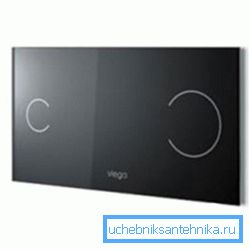
Features of installation and disassembly of designs with buttons
To begin with, let's look at how to work with classical constructions, of which the vast majority in our country. The toilet flush system with a button is most often used because of its simplicity and aesthetic appeal.
Disassembly of tanks with button system
Often you can meet the question of how to remove the cover from the toilet - the button is locked, and there are no slots and slots on the outside. In fact, such a formulation is incorrect, because the tank lid is removed, and this can be done with your own hands without complicated devices and special tools.
Tip! Some unscrupulous plumbers claim that the system is not collapsible, and only a specialist will be able to remove the cover, in fact this is not the case, any person can handle the work.
It is worth noting that the drainage system 2 buttons for toilet bowls are not as disassembled as the single variants, so we will consider each of the types separately.
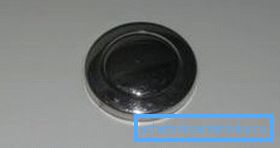
Consider how to open the toilet lid with a button of the old sample:
- To remove the need for a flat screwdriver with a thin wide slot, with its help, and will be made the bulk of the work.
- The first slot is inserted under the frame of the element and gently rotated counterclockwise. Your task is to move the ring off, then it will be easily unscrewed with your bare hands.
- This element is turned out and removed, then you can slightly raise the lid and gently rotate it 90 degrees. After that, you can get to the double-sided latch-clothespins, squeezing it and turning it on the axis, you can release the cover and remove it.

After that, you can start the maintenance and repair of the system.
For example, consider the situation when the button does not rise in the toilet - the fault occurs very often, the most common reasons are as follows:
- The button of the toilet sinks due to poor-quality connections and breakdowns of the loads. Help can only replace damaged parts or the entire node.
- Very often, the reason is the poor quality of water - the presence of rust and mechanical impurities in it is very often the reason that the button on the toilet flushes. The way to solve the problem is simple: the structure is disassembled, washed and lubricated with linseed oil or silicone lubricant. This procedure can be repeated from time to time.
Remember! As a rule, malfunctions inside the tank are very easy to detect - just carefully inspect each node. All moving parts should be easy to walk, all connections should be tight, the design should not be skewed.
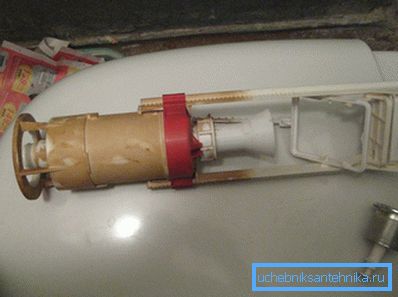
Consider how to disassemble the toilet with a button, which consists of two parts so that you can make a drain, both in full and in economy mode.
Works are performed as follows:
- The smaller part of the button is pressed, and a slot is opened on the inside of the other part of it, a screwdriver with a flat blade is inserted into it, and the element is removed upwards.
- After that, the second part also goes, and a plastic screw is visible in the opened cavity. It is necessary to unscrew, after which you can carry out the following work.
- The further process is similar to that described above: the lid is raised and rotated 90 degrees, after which the latch is compressed and the button body is removed. The cover can be removed and continue the necessary work.
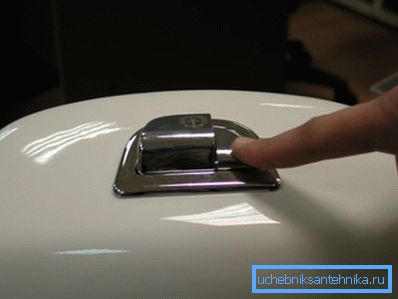
The design itself of such valves is distinguished by the fact that it has two modes that allow you to save water by draining only half the volume of the tank.
Works in systems with suspended toilet bowls

This version of the design has very serious differences, so the instructions for the work has its own characteristics:
- The button for installation for a toilet bowl usually has a large size, because if necessary it is through it that the tank is accessed. If necessary, the button is gently removed from the latches with a thin screwdriver, and the decorative panel is unscrewed. Moreover, it is the way of dismantling all such structures.
- If you use pneumatic buttons, then the cause of failures in their work may be a violation of the power supply system or the opening valve. As a rule, troubleshooting requires a certain qualification, so it is better to involve specialists.
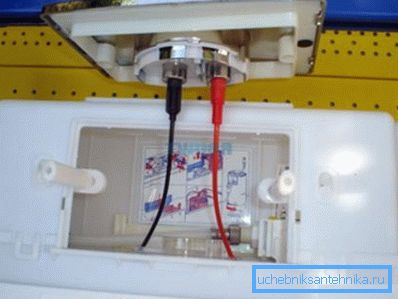
- If there are failures in the sensor controls, only the integrity of the power cable can be checked.. All other work can only be done by specialists, so it is highly undesirable to interfere with such a system.

Whichever option you choose, remember that the reliability of the system depends largely on the quality of the elements used. Purchase options that you can trust, and you do not have to disassemble the system and repair it.
Conclusion
In fact, all the work is quite simple, the main thing is to be careful when carrying out the work. The video in this article will describe some aspects of the workflow in more detail (see also the article Button for a cistern: design features and operating rules).